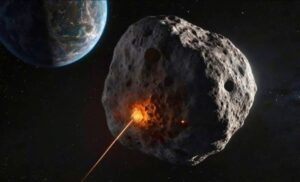GS-3: Space Technology

Key Highlights
- NASA earlier flagged asteroid 2024 YR4 as a potential threat with a 3.8% chance of hitting the moon on December 22, 2032.
- New trajectory data indicates YR4 is unlikely to hit either Earth or the Moon.
- YR4 is a near-Earth asteroid, classified as potentially hazardous due to its orbit and size (~68m wide).
- If it were to hit the moon, the explosion could be 300 times stronger than the Hiroshima bomb.
- Astronomers are divided on whether such an impact would be visible from Earth due to the moon’s brightness.
Detailed Insights
- Near-Earth objects (NEOs) like YR4 are tracked for potential collision threats if they pass within 1.3 AU (Astronomical Units) of Earth.
- YR4 is currently listed on NASA’s Sentry Risk Table, which ranks potential impacts from asteroids on a Torino scale of 0 to 10. YR4 has a rating of 1, meaning no immediate threat.
- Scientists use telescopes like ATLAS, Pan-STARRS, and space-based tools to improve tracking and reduce collision uncertainty.
- A moon impact would create a 500-2,000 m crater, visible only under certain lunar conditions.
Scientific/Technical Concepts Involved
- Near-Earth Object (NEO): An asteroid or comet whose orbit brings it close to Earth.
- Torino Scale: A method of categorizing the impact hazard associated with NEOs.
- Sentry System: NASA’s impact monitoring system using long-term orbital predictions of hazardous asteroids.
- Infrared vs Optical Detection: Different wavelengths provide different insight into asteroid size and orbit.
Significance
- The episode underscores the importance of planetary defense systems.
- It builds awareness about how space agencies track and assess risks from cosmic bodies.
- Contributes to disaster risk preparedness and global coordination for asteroid defense, e.g., NASA’s DART mission.
- Highlights scientific capability in orbit modelling, impact prediction, and mitigation planning.




